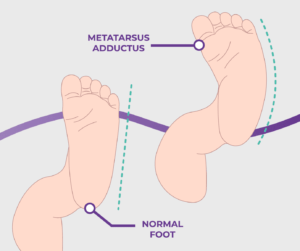Metatarsus Adductus – Causes, Symptoms, and Treatment Options
- Dr Maryum Sohail
- February 15, 2024
- 10:33 pm

Metatarsus adductus, also known as metatarsus varus is a common congenital condition in which the foot appears bean-shaped with the front part of the foot turning in towards the midline of the couch, this condition has a fairly good prognosis with spontaneous recovery around the school-age years with only 10-15% of these cases presisting.
What are the usual causes of metatarsus adductus?
The actual reason that the metatarsus adductus happens is unclear. None of the theories regarding the cause of metatarsus adductus are proven. However, factors such as intrauterine positioning, tight uterine space, and poor muscle activity have all been considered possible causes of metatarsus adductus.
One or two feet may be impacted, and it normally will, in general, disagree families actually intending that on the off chance that one kin or guardians had the condition, the other youngster might have it as well.

What are the various kinds of metatarsus adductus?
There are two principal kinds of metatarsus varus irregularities: an adaptable sort in which the impact point and forefoot can be lined up with delicate strain over the foot. On the contrary, in the rigid type, the forefoot may be difficult to align to the heel with such gentle manipulation.
Does metatarsus adductus/varus affect walking?
Metatarsus adductus is a bony condition; .presistence of the condition usually does not imply any functional deficits; moreover, in most children, the foot usually straightens out as they grow by the age of 4 years.
How do I know that my child has a metatarsus adductus?
The V-finger test is a basic device that can be utilized to decide whether your youngster has metatarsus adductus wherein the geel of the kid is put between the list and the third finger. This allows the observation of the forefoot relative to the heel.
What are the treatment options for metatarsus adductus?
The treatment for metatarsus is usually well tolerated and depends upon:
- Age of the child.
- The severity of the condition
- Association with other medical conditions.
- Type of metatarsus.
Also, Check: syndactyly the appearance of webbed digits in children

Options for treatment include:
- Observation.
- Physiotherapy and passive stretching.
- Casts.
- Orthotopic support.
- Rarely surgery.
How can exercise help?
Regular gentle exercises help, especially when the child is in a relaxing environment.
Baby’s foot from the front should be gently brought out to the extent that the feet and heel align with each other, and the position is to be held for 10-30 sec; this stretching should not be painful.
Gentle stroking of the outer border of the foot so that the foot moves in a neutral position should also be encouraged.
What if physiotherapy is not helping?
If stretching exercises are ineffective, serial long leg casting may be used to correct the deformity, especially in older children above the age of 2 years.
In this procedure, the child’s foot is kept in a cast while gradually stretching it with each change of cast, which may be done weekly or every two weeks.
What are metatarsus adductus shoes?
One of the treatment options for the metatarsus adductus is specialized shoes or inserts designed to support the forefoot in a corrected position. They can be used alone or in conjunction with stretching and physiotherapy programs.

Also, Check: hay fever
Metatarsus adductus versus club foot
Metatarsus adductus is a condition that affects only the forefoot, where only the front of the foot is curved inward. It is a milder condition that resolves mainly as the child grows and does not, in the majority of cases, lead to any functional disability.
On the other hand, clubfoot is a more serious abnormality in which the forefoot along the heel is facing inwards. Treatment requires serial casting, and the presence of clubfoot may have functional consequences.
Dr Maryum Sohail
Subscribe to Dr Owais YouTube channel
For parenting advice, child health, symptoms, causes and treatment of illness in children.





